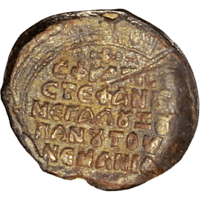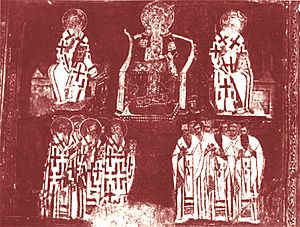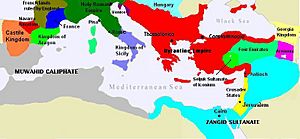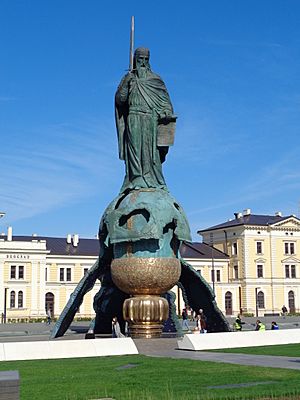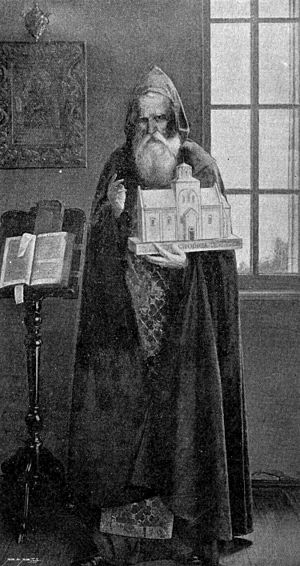Stefan Nemanja facts for kids
Quick facts for kids SaintStefan Nemanja Стефан Немања |
|
|---|---|
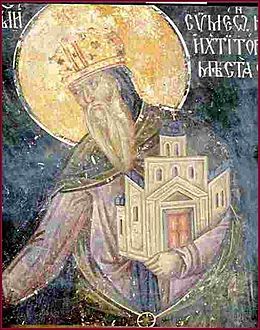
Donor's portrait of Stefan Nemanja, fresco in the Virgin's Church of the Studenica Monastery
|
|
| Simeon the Myrrh-streaming | |
| Venerated in | Eastern Orthodox Church |
| Attributes | Church Builder |
Stefan Nemanja (born around 1113 or 1114 – died February 13, 1199) was a very important ruler in Serbian history. He was the Grand Prince (or Veliki Župan) of the Grand Principality of Serbia from 1166 to 1196. He started the powerful Nemanjić dynasty, which ruled Serbia for a long time.
Nemanja is remembered for building up the Serbian state and helping to establish the Serbian Orthodox Church. Many people consider him one of the most important Serbs ever. He was also known for his writings and his kindness.
In 1196, after about 30 years of ruling, Nemanja decided to step down. He gave the throne to his middle son, Stefan Nemanjić, who later became the first King of Serbia. Nemanja then went to Mount Athos, a special place for monks, and became a monk himself, taking the name Simeon. He joined his youngest son, Saint Sava, who was already a monk there and later became the first leader of the Serbian Orthodox Church.
Together with his son Saint Sava, Nemanja helped rebuild the Hilandar Monastery on Mount Athos. This monastery became a key center for Serbian Orthodox monks. After Nemanja passed away, the Serbian Orthodox Church declared him a saint, known as Saint Simeon the Myrrh-streaming.
Contents
Early Life of Stefan Nemanja
Stefan Nemanja was born around 1113 or 1114 in a place called Ribnica. This area is near what is now Podgorica, the capital of Montenegro. He was the youngest son of Zavida, a prince from a region called Zahumlje.
Zavida had moved to Ribnica after a disagreement with his brothers. Because western Zeta, where he was born, was under Roman Catholic influence, Nemanja was baptized in the Latin tradition. However, he spent much of his life balancing between Western and Eastern Christian traditions.
Later, Nemanja's family moved to Raška. This happened after Byzantine armies defeated some of his relatives.
Battles and Rise to Power
In 1163, the Byzantine Emperor Manuel I Comnenus came to Niš. He wanted to deal with issues in Serbia. At that time, Serbia was led by Grand Prince Desa, who was allied with Hungary. Emperor Manuel did not like this.
Desa was eventually captured and sent to prison in Constantinople. Emperor Manuel then gave control of the land to Zavida's sons, who were more friendly to the Byzantines. Zavida had four sons: Tihomir, Stracimir, Miroslav, and the youngest, Nemanja. Tihomir was the oldest and became the Grand Prince of Raška.
Each brother ruled a different part of Raška. Stracimir ruled areas around West Morava, Miroslav ruled Zahumlje, and Nemanja controlled areas around Ibar, Toplica, and Dubocica. Stefan Nemanja was married to Saint Anastasija. They had three sons: Vukan, Stefan, and Rastko, and three daughters.
Conflicts with Hungary and Venice
The Byzantine Emperor Manuel I Comnenus launched a large army against Hungary. The Byzantines wanted to control more land. In 1165, the Byzantine army conquered Zemun and Srem. Serbian soldiers also joined the Byzantine forces.
Another Byzantine army moved west, taking cities from Split to Bar. They made these cities recognize Byzantine rule.
Meanwhile, Venice, a powerful city-state, became worried about Byzantium's growing power. Venice joined forces with Hungary against the Byzantines. They also encouraged Serbs to rebel against Byzantium.
In 1166, Hungary attacked to regain lost areas. Emperor Manuel responded by sending three armies into Hungary. The Hungarians were forced to make peace in 1167.
Nemanja's Imprisonment and Escape
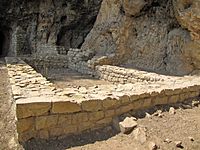
Nemanja became a good choice for Venice and Hungary to support. His brothers, especially Grand Prince Tihomir, imprisoned him in a cave near the Fortress Ras. Nemanja had hoped to replace Desa as ruler, but Emperor Manuel had put his older brother Tihomir on the throne instead.
Angry about this, Nemanja changed his mind and decided to support Hungary and its allies. He managed to escape from the prison. His son and biographer, Stefan Nemanjić, wrote that Nemanja escaped with the help of "heavenly forces."
Becoming Grand Prince (1168–1172)
In 1166 or 1167, Nemanja gathered his supporters in Ras. He started a conflict against Tihomir, who was supported by the Byzantines. Nemanja defeated Tihomir. The main battle happened near Pantina in Kosovo in 1168. Tihomir's army was defeated, and he drowned in the Sitnica river while retreating.
After this, Nemanja attacked Prince Radoslav of Zeta, who was a Byzantine ally. Nemanja added parts of Zeta and the Neretva region to his country.
Soon, Emperor Manuel I Komnenos had a conflict with Venice. In 1171, all Venetian property in Byzantium was taken. Venice responded by sending a large navy to attack Byzantine lands. Nemanja then formed closer ties with Venice. He began attacking Byzantine Kotor and raiding the Moravian valley, which was an important road between Belgrade and Niš.
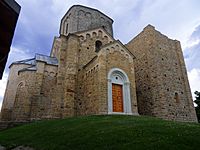
In 1172, the Hungarian king Stephen III died. This was a problem for Nemanja, as he expected Hungarian help. The new Hungarian king, Bela III, was supported by Emperor Manuel. Meanwhile, the Venetian army was weakened by an illness. This left Nemanja alone in his fight against Byzantium. Emperor Manuel quickly marched his army towards the Serbs. Grand Prince Nemanja retreated to the mountains.
Nemanja Becomes a Byzantine Ally (1172–1182)
This conflict ended with Nemanja surrendering to Emperor Manuel. Nemanja went to Niš, barefoot, with torn clothes, a rope around his neck, and a sword in his hands. He knelt before the emperor, offering his sword and asking Manuel to do with him as he wished.
Emperor Manuel accepted Nemanja's surrender. He allowed Nemanja to remain Grand Prince, but Nemanja had to promise to be loyal to Byzantium. Nemanja was then taken to Constantinople as part of Manuel's victory parade.
After returning to Raška, Nemanja focused on strengthening his rule. He made Tihomir's son, Prvoslav, give up his claims to the throne.
As a loyal ally, Nemanja regularly sent Serbian soldiers to help in Byzantine military campaigns. Serbian troops were part of the Byzantine army that fought against the Sultanate of Rum in the Battle of Myriokephalon in 1176.
Dealing with Bogumilism
During this time, a religious movement called Bogumilism was spreading in the Balkans. This teaching was different from the main Christian beliefs and often resisted Byzantine state and church authorities.
Bogumilism was very popular among people in Raška and Bosnia. Nemanja decided to take action against it. He called a special meeting of state and church leaders around 1176. At this meeting, Nemanja spoke about the dangers of the Bogumil teaching. A woman married to a Bogumil leader gave important testimony.
After discussions, Nemanja decided on measures against them. The leader of the Bogumils in Raška was caught. Nemanja spared his life but ordered his tongue to be cut off so he could not spread his teachings anymore. Soldiers were sent to areas where Bogumilism was strong, mainly to encourage people to change their beliefs.
Those who refused to change had their property taken away. Some faced milder punishments, their books were burned, and they were expelled from the country. Their confiscated property was given to the sick and the poor.
War with Byzantium (1183–1191)
When Emperor Manuel died in 1180, the Hungarian king Bela III felt he no longer had to obey Byzantium. In 1181, Hungary attacked Byzantium, taking Srem and parts of the Adriatic coast. Byzantium was having internal problems, so they couldn't respond militarily.
In 1182, Bela III ordered an attack on Byzantine Belgrade and Braničevo. At the same time, a new emperor, Andronikos I Komnenos, took power in Constantinople. This change meant Nemanja was no longer bound to the Byzantine emperor.
Stefan Nemanja, allied with the Hungarian king Bela III, launched a major attack on Byzantium in 1183. Serbian forces, led by Nemanja, joined this campaign. The next year, Nemanja attacked the southeastern Adriatic coast, conquering Skadar and besieging Dubrovnik.
In 1185, Andronikos I was killed in Constantinople. The new Byzantine emperor, Isaac II Angelos, began peace talks with the Hungarian king. The Hungarian army left the central Balkans, leaving Nemanja without their support. Luckily for Nemanja, the Normans and Bulgarians also joined the fight against Byzantium.
Nemanja made Dubrovnik switch its loyalty from Byzantium to Norman rule. The Normans also captured Dyrrachium and Thessalonica. In October 1185, an uprising began in northern Bulgaria, led by the brothers Peter and Ivan Asen. Nemanja then worked with the Asen brothers against Byzantium.
Meeting Emperor Frederick Barbarossa
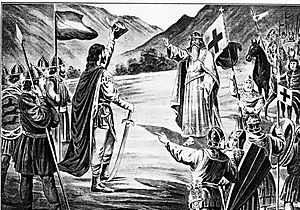
Meanwhile, in 1187, the Muslim leader Saladin captured Jerusalem. This led to the Third Crusade in Europe. A large crusader army, led by Holy Roman Emperor Frederick Barbarossa, marched through the Balkans in 1189.
In Niš, which was Nemanja's new capital, the German emperor and Nemanja met in July 1189. Nemanja asked Barbarossa to join him in a war against Byzantium. However, Barbarossa politely refused. He only wanted safe passage for his army through Byzantine lands to reach Jerusalem.
A month later, talks between the Crusaders and Byzantines became tense. The Crusaders captured Philippopolis and Adrianople and prepared to attack Constantinople. Nemanja used this chance to attack Byzantine Skopje. In February 1190, an agreement was reached between the two emperors, allowing the Crusaders to cross the Dardanelles.
In June 1190, Frederick Barbarossa drowned in a river. At the same time, Byzantine Emperor Isaac II Angelos launched an attack against the Serbs. Nemanja was defeated in the battle of South Morava. Byzantium did not want to fully conquer Serbia but wanted to regain Niš and the main road to Belgrade. A peace treaty was signed. It arranged for Nemanja's middle son, Stefan Nemanjić, to marry a Byzantine princess, who was the emperor's niece.
Return to Byzantium and Abdication
The peace agreement meant that Nemanja's middle son, Stefan, would be his successor. Stefan received the Byzantine title of sebastokrator and married the Byzantine princess Eudokia Angelina. This was important because it meant his oldest son, Vukan, would not inherit the throne.
In 1193, the Hungarian king Béla invaded Serbia. Emperor Isaac II demanded that Hungary withdraw its troops. In April 1195, Stefan Nemanjić's father-in-law, Alexius III Angelus, overthrew his brother Emperor Isaac II and became the new Byzantine emperor.
In 1196, at a state assembly near the Church of Saints Peter and Paul in Ras, Stefan Nemanja gave up his throne. He handed power to his middle son, Stefan, who became the Grand Prince of Serbia. He left his oldest son, Vukan, in charge of Zeta and other regions.
Nemanja became a monk in his old age and took the name Simeon. Soon after, he went to Mount Athos in Byzantium. His youngest son, Sava, was already a monk there. They received permission from the new Byzantine emperor to rebuild the abandoned Hilandar Monastery.
Death and Legacy
Knowing he was close to death at 86 years old, Simeon asked to be placed on a mat in front of an icon of the Virgin Mary. He died on February 13, 1199, with his son Sava and other monks by his side. He was buried at Hilandar monastery. His last wish was for Sava to bring his remains back to Serbia when the time was right. Sava later wrote a special prayer in Nemanja's honor.
In 1206, Sava decided to bring his father's remains to Serbia. At that time, his brothers Stefan and Vukan were fighting, which was dividing the Serbian lands their father had united. When Sava arrived, his brothers made peace. Simeon was re-buried in 1207 in his own monastery, the Studenica Monastery. From his new grave, a special holy oil (myrrh) began to flow, which is why he was called the Myrrh-streaming.
Because of the miracles that happened at his grave, the Serbian Orthodox Church declared him a saint. His feast day is celebrated on February 26 (February 13 in the old calendar). The worship of Saint Simeon helped strengthen Serbian national identity. His main places of worship are the Studenica and Hilandar monasteries.
Names and Titles
Stefan Nemanja was known by several names. Sometimes he is called Stefan I or, in Latin, Stephanus Nemania. His name is also sometimes spelled Stephen Nemanya.
Later in his life, when he became a monk, he was called Monk Simeon or Monk Symeon. After his death, the Orthodox Church made him a saint, and he became known as Saint Symeon the Myrrh-streaming.
His son and successor, Stefan the First-Crowned, called him "The Gatherer of the Lost Pieces of the Land of his Grandfathers, and also their Rebuilder." His other son, Sava, called him "Our Lord and Autocrat, and ruler of the whole Serbian land." Both sons helped create the idea of their father as a ruler-saint, which was a unique idea in the Byzantine world.
Family Life
Nemanja was married to a noblewoman named Ana. They had three sons and three daughters:
- Vukan Nemanjić – He was Prince of Doclea and briefly Grand Prince of Serbia.
- Stefan Nemanjić – He was Nemanja's successor and became the first King of all Serbian lands.
- Rastko Nemanjić (Saint Sava) – He became the first archbishop and a saint of the Serbian Orthodox Church.
- Jefimija Nemanjić – She married Manuel Komnenos Doukas.
- A daughter who married a Bulgarian nobleman named Tihomir Asen. She was the mother of the Bulgarian emperor Konstantin Tih.
- Elena-Evgenia, wife of Ivan Asen I
Monasteries and Churches
Stefan Nemanja built, restored, and rebuilt many monasteries and churches. He also started the Raška architectural school, which was important for Serbian architecture from 1170 to 1300.
Foundations (New Constructions)
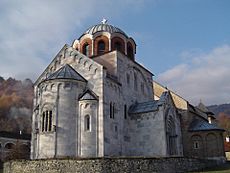
- Monastery of Saint Nicholas, in Kuršumlija
- Monastery of Saint Mother of Christ, between Kosanica and Toplica
- Monastery Temple of George's Tracts (Đurđevi Stupovi), built in 1171 in Ras
- Monastery Temple of the Immaculate Holy Virgin the Benefactor (Studenica), built in 1190 in Ibar
- Church of Saint Mother of Christ, at the meeting point of the Bistrica and the Lim rivers
- Monastery of Saint Nicholas, in Kaznovići/Končulj on the Ibar
- Nunnery of Mother of Christ, in Ras
Reconstructions (Repaired or Improved)
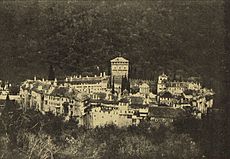
- Hilandar monastery on Mount Athos, in 1199
- Monastery of Saint Archangel Michael, in Skopje
- Monastery of Saint Pantheleimon, in Niš
Donations (Support for Churches Elsewhere)
- Church of Lord, Holy Grave and Christ's Arrisal, in Jerusalem
- Church of Saint John the Forerunner, in Jerusalem
- Church of Saint Theodosios, in the Desert of Bethlehem
- Church Saint Apostole Peter and Paul, in Rome
- Church of Saint Nicholas, in Bari
- Monastery/Church of the Virgin of Evergethide, in Constantinople
- Monastery/Church of Saint Demetrios, in Thessalonika
See also
 In Spanish: Esteban Nemanja para niños
In Spanish: Esteban Nemanja para niños
- Battle of Pantina
- History of Serbia; List of Serbian monarchs
- History of Montenegro; List of rulers of Montenegro
- History of Herzegovina



